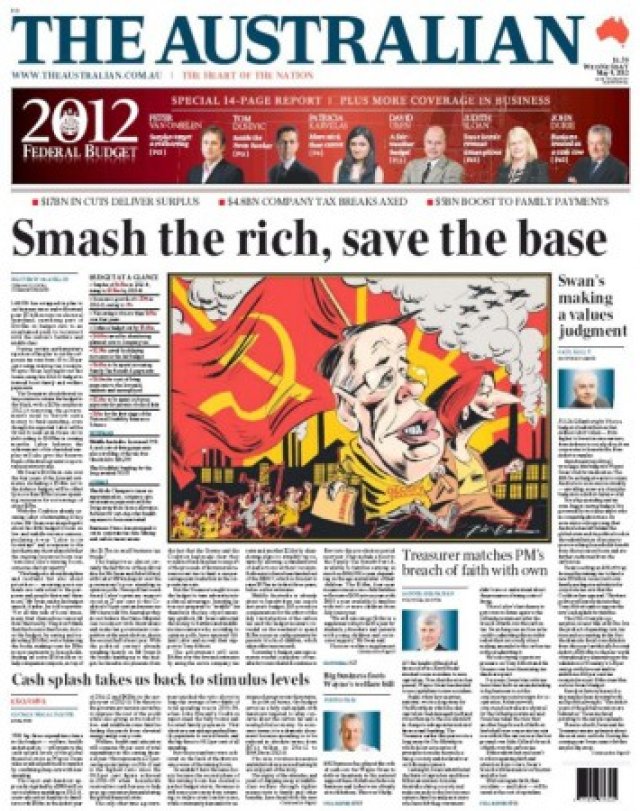
Is there a surplus or is there not? Does delivering a $1.5 billion surplus in 2012-13 make Wayne Swan a “good economic manager”? Are you a winner and grinner or a loser soon to be driven to the boozer? Blah, blah, blah. Enough, enough already with the budget spins and counterspins.
You want something real to worry about from the budget? Worry about your job if you are lucky enough to still have one, and worry about what will happen to you if you lose it.
Because beyond the little bribes and fiddles in the Labor government’s desperate budget, the bad news is for the jobless, whose numbers are predicted to grow.
The official unemployment rate is now 4.9% and the budget predicts it will rise to 5.5% next year. However, Roy Morgan predicts the real unemployment rate will reach 9.3%. A survey this month found that about 1.2 million Australians were unemployed and looking for work.
A further 8.2% were working part-time and looking for more work. In total, more than 2.16 million Australians, or 17.5%, were unemployed or underemployed.
Another recent survey by Macquarie University researchers found that Australians' biggest worry was about their jobs, and how to keep them. Job insecurity has been on the rise as permanent full-time jobs are replaced by casual and part-time jobs.
The budget axed 4200 full-time public sector jobs. The ABS said that 26,000 part-time positions were created Australia-wide in April, but 10,500 full-time jobs disappeared.
Roy Morgan estimates the Australian workforce in April was 12,307,000, ― comprising 8,131,000 full-time workers; 4,176,000 part-time workers (up 183,000 since April last year) and 1,149,000 looking for work (up 302,000 since April last year).
Australia is a leader in casualisation of labour in the developed world, outranked by only Spain. Since 1984, casual employment in Australia has grown from 15% to a quarter of the workforce.
Contractors now make up 10% of workers and non-permanent jobs have grown to 40% of the workforce.
So what does the budget offer the growing jobless? The Newstart Allowance of $243 a week will remain $50 a week below the poverty line and sole parents without a job will be bumped down to this level once their youngest turns eight.
One of the little bribes in the budget is a woeful “supplementary allowance” for the unemployed, students and parents with young children — those hardest hit by the rises in the cost of living — of yearly payments of $210 for singles and $350 for couples, which won’t actually be paid for a year.
The heartlessness of these attacks on some of the most vulnerable in Australia matches that of its $2.9 billion cut to foreign aid over four years, a move that will lead to the deaths of up to 200,000 people, according to Tim Costello from World Vision.
But why are the jobless numbers predicted to rise? Didn’t Australia escape the global recession? The short answer is “not completely”. Overall GDP is growing, but this is largely due to growth in the mining and resources sector. This sector accounts for 15-20% of GDP but employs less than 2% of the workforce.
Meanwhile, the rest of the economy is “subdued” in Reserve Bank-speak.
The budget papers said the resources sector was “expected to grow strongly” but other parts will be “uneven” There was particular concern for retail, manufacturing and tourism, all big job providers.
The budget desperately tries to paint the few election bribes delivered as “spreading the benefits of the mining boom”.
The Liberal-National opposition says this is all the fault of the pathetic and ineffective feint by the Gillard Labor government at doing something about the climate change crisis.
But the slashing of jobs and the growing insecurity is not down to the yet-to-be introduced carbon price/emissions trading scheme. It’s all down to the capitalist system that is still dogged by an unresolved global economic crisis.
The public is being forced to pay for the sins of greed of the capitalist bankers ― even in Australia.
Well-paid union bureaucrats would have us believe that subsidising the boss will save our jobs even while the most-heavily subsidised companies ― GMH, Toyota and Ford ― show otherwise by laying off thousand of workers.
Instead of cheering on the government for delivering “tax relief for struggling businesses”, the trade union movement could have championed a defence of working class interests, including those forced out of a job. They could have raised their voices for social justice and urgent public investment in an ecologically sustainable future.
Though we are a long way from this, there could be an altogether different approach to this crisis if the 99% were able to marshall their potential power to put the country on a course that is in our common interest.

Comments
Anonymous replied on Permalink
Anonymous replied on Permalink